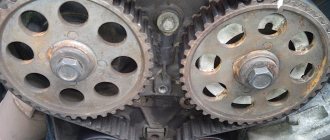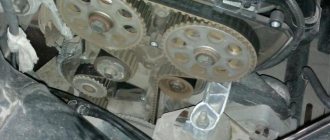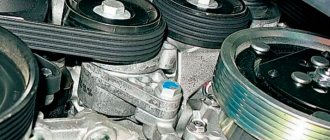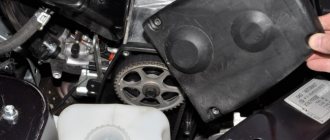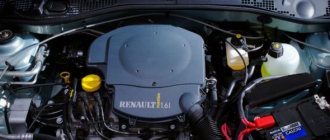September 16, 2020 Lada.Online 119 757 24
Why do LADA owners care about the frequency of replacing the timing belt (gas distribution mechanism) on their cars? Mainly due to the consequences of a broken belt, in some cases the valve bends, which ends in expensive repairs. Let's figure out at what mileage the manufacturer recommends changing the timing belt and rollers, as well as what its actual service life is.
Part numbers
Since the engines installed in the piston bottom do not have grooves for the valves to prevent them from bending when the belt breaks, there is no need to save on this consumable. It is preferable to install an original belt or a replacement from Contitech and Gates.
Original
In the spare parts catalog of JSC AvtoVAZ, the required spare parts are indicated by the following numbers:
- 2108-01006040-82 for engine 11189;
- 8201069699 for engines 21129 and 21179.
The minimum price on exist.ru is 360 and 2500 rubles, respectively.
Substitutes
| Manufacturer | vendor code | Minimum price on exist.ru, rub. |
| For 2108-01006040-82 | ||
| Bosch | 1 987 949 095 | 340 |
| Contitech | CT-527 | 330 |
| Dayco | 94738 | 410 |
| For 8201069699 | ||
| Contitech | CT-1179 | 1050 |
| Dayco | 94847 | 930 |
| Gates | 5671 XS | 1800 |
| Npa | NP511-01622 | 450 |
| Renault | 8201069699 | 1700 |
AVTOVAZ recommendations
It is immediately worth noting that on the official LADA website in the maintenance calculator (it is only up to 90 thousand km) nothing is said about replacing the timing belt and rollers. However, information about this is in the service book of some LADA models.
Lada Priora:
No information available.
Lada Granta, Kalina:
- The 2015 service book indicated that for the 8-valve engine, replacement is provided at a mileage of 75,000 km.
- The 2022 service book states that the timing belt, tensioner and support roller (if equipped) should be replaced at a mileage of 180 thousand km.
- From June 2022, the timing belt must be replaced at 90,000 km.
Lada Largus:
- Engine Renault K4M (1.6 16V). The timing belt and rollers should be replaced at 120 thousand km or 6 years.
- Engine VAZ 11189 (1.6 8V). The timing belt and rollers should be replaced at 160 thousand km or 8 years. It is noteworthy that the Lada Vesta service book (until 2022) indicated that on the VAZ-11189 engine, replacement is provided at a mileage of 180,000 km (until 06.2021) or 90,000 km (from 06.2021).
Lada Vesta, XRAY
:
- Engine VAZ-21129 (1.6l., 16kl.). The timing belt along with the rollers should be replaced at a mileage of 180,000 km (until 06/2021) or 90,000 km (from 06/2021).
- Engine VAZ-21179 (1.8l., 16kl.). The timing belt along with the rollers should be replaced at a mileage of 180,000 km (until 06/2021) or 90,000 km (from 06/2021).
Conclusion
:
- AVTOVAZ periodically changes the regulations for replacing timing belts and rollers.
- From June 2022, according to the regulations, the timing belt must be replaced at a mileage of 90,000 km.
Replacing the timing belt on Vesta with engine 11189 (1.6 liters, 8 valves)
The procedure is as follows:
- Place the car on the inspection hole and raise the parking brake lever. Loosen the nuts on the right front wheel.
- Remove the decorative engine cover.
- Raise the car on a jack, install a stand and remove the jack.
- Remove the wheel.
- Remove the gas distribution mechanism cover by unscrewing 3 bolts with a 10mm head.
- Loosen the bolt securing the generator to the bracket on the cylinder block, move it towards the block and remove the generator belt.
- Align the marks on the camshaft pulley and the cylinder head by rotating the crankshaft clockwise with the head “17”. To make rotation easier, it is recommended to unscrew the spark plugs.
- Lock the crankshaft by inserting a screwdriver into the flywheel teeth through the starter hole. To remove the starter, you need to disconnect the power wire by unscrewing the nut with a “13” head and unscrew the 3 mounting bolts with a Torx E10 head.
- Unscrew the bolt from the crankshaft using a 17mm socket with an extension from a hollow tube and remove the generator pulley and the washer underneath it.
- Loosen the nut securing the tension roller by half a turn with the socket “15”.
- Remove the belt.
- Install the new part by sliding the left leg onto the water pump pulley and roller, and then onto the camshaft pulley.
- Insert pliers into the grooves on the tension roller and turn it until the 2 rectangular marks coincide and tighten the nut with the head “15”.
- Check for correct installation by turning the crankshaft 2 turns. If the marks on the pulleys and the engine do not match, reinstall the belt. Otherwise, install all the removed parts back.
Analogue belt brands
If we talk about the best brands, then Gates, Contitech, Dayco and Bosch are the most promising in the segment and enjoy decent popularity.
Drivers trust spare parts from the Belgian company Gates, whose manufacturers supply their products to car factories.
When choosing timing belts, you should choose the original, which may be more expensive in price, but will last a long time. We wish you that your timing belt never breaks and is serviced on time!
Replacing the timing belt on Vesta with engine 21129 (1.6 liters, 16 valves)
- The procedure is as follows:
- Follow steps No. 1-4 from the previous method.
- Remove the right engine mount:
- Remove the engine splash guard (protection) by unscrewing 13 bolts with a 10mm head.
- Place a jack under the oil pan and lift the engine.
- Using a 16mm head, unscrew the 2 bolts securing the support to the body.
- Lower the right side of the engine until the support is below the lower edge of the side member.
- Unscrew the 2 bolts securing the support to the engine using a Torx E12 head and remove it.
- Unscrew the 5 bolts from the upper cover of the gas distribution mechanism with a hexagon and remove it.
- Unscrew 10 screws using a T20 Torx bit and use a screwdriver to pull out the fasteners securing the right fender liner to the body and remove it.
- Remove the accessory belt:
- Use a slotted screwdriver to pry up the plug on the tension roller.
- Using a 13mm head, loosen the nut on the roller
- Insert the T55 bit into the groove on the roller. Turn the part clockwise, loosening the tension, and remove the belt.
- Turn the crankshaft with the head “17” until the marks on the camshaft pulleys (convex points) coincide with the marks on the cylinder head cover (triangular slots in the plate).
- Follow step No. 8, 9 from the previous method
- Unscrew the 3 screws using a hexagon that secure the lower timing case cover to the cylinder block.
- Follow steps No. 10, 11 from the previous method.
- Place the right branch of the new part on the crankshaft pulley, the intake camshaft (right), and the exhaust camshaft (left), one by one.
- While holding the right arm taut, place the belt over the water pump pulley and tensioner pulley.
- Follow steps No. 13 and 14 from the previous method.
Powertrain options
The car was initially equipped with three different power units: two engines with a displacement of 1.6 liters and one 1.8 liter. The AvtoVAZ plant designed the so-called 27th and 29th engines, or their full markings - 21127 and 21129. The first one had to be abandoned over time. The VAZ-21127 engine had a long service life and good technical characteristics, but its non-compliance with Euro-4 standards forced AvtoVAZ engineers to look for a way out of this situation. The solution was found in the following - to bring environmental performance indicators to perfection by modernizing the engine.
The difference between these two power units is as follows:
- The compression ratio was reduced from 11.0 to 10.45 in the 29th engine;
- The control unit controller received new firmware with a completely different algorithm;
- The exhaust and resonance starting system has undergone modernization;
- The parts of the connecting rod and piston group have been lightened.
The new engine has joined the ranks of 16-valve engines. In general, the manufacturer managed to technically improve the Lada Vesta engine without changing the displacement or loss of power. You can also find a modification with a Nissan HR16 DE power unit under the hood. It was designed with the help of foreign engineers. The Nissan engine works effortlessly on both the AI-92 and AI-95. At the same time, the internal combustion engine was equipped with a chain instead of a timing belt, which allowed it to outperform its counterpart somewhat in terms of actual service life.
Where can I buy?
Before starting work, you must purchase all the necessary components:
- Timing belt;
- Tension roller;
- Bypass roller;
- Water pump.
The table shows original spare parts with prices and articles
| Online store | vendor code | Price, rub.) |
| Timing belt | ||
| https://www.port3.ru/search/RUSSIA/8201069699 | 8201069699 | 2639 |
| https://www.detali.ru/code/lada/8201069699 | 8201069699 | 2333 |
| https://www.avtozapchasty.ru/shop/i.php?id=8724241 | 8201069699 | 2039 |
| Tension roller | ||
| https://www.autopiter.ru/goods/8450006996/avtovaz/id111906755 | 8450006996 | 1339 |
| https://cardone.org/market/catalog/originaly/LADA/Rolik-natyazhnoj-v-sbore-LADA-8450006996 | 8450006996 | 1644 |
| https://grantauto.satom.ru/p/239517334-rolik-lada-vesta-natyazhitelya-remnya-privodnogo-ina-8450006996/ | 8450006996 | 1701 |
| Idler roller | ||
| https://navigator74.net/p68776801-rolik-opornyj-remnya.html | 21126-1006135 | 500 |
| https://www.avtozapchasty.ru/shop/i.php?id=321802 | 21126-1006135 | 674 |
| https://www.centr-tuning.ru/ru/shop/index.php?productID=117283 | 21126-1006135 | 480 |
| water pump | ||
| https://dvizhcom.ru/parts/lada/211261307010/ | 211261307010 | 1535 |
| https://avtozapchasti52.rf/products/LADA/211261307010.html | 211261307010 | 1468 |
| https://www.port3.ru/search/RUSSIA/211261307010 | 211261307010 | 1010 |
Four Well-Known Facts
The service life of the timing chain always exceeds the service life of the engine. This is the first fact, but a condition must be met: the oil change must be timely. In general, the circuit fails gradually, and this is accompanied by symptoms:
- Audible sounds (chirping) at idle speed;
- When the “problem area” passes, a phase shift may be observed.
The last defect is detected using computer diagnostics.
From the appearance of any symptom to the complete rupture of the chain, a certain time passes. And in general, a “defective circuit” can work for a long time. This was another, fourth fact.
Cost of timing belt repair kit
An original repair kit for a 16-valve Vesta engine costs from 3,000 rubles. The price of analogues takes the value of 2900-3700 rubles. Separately, the original timing belt (article 21126100604000) will cost 1,700 rubles. AvtoVAZ offers a reinforced version for 1900 rubles.
Replacing the clutch. Photo source: https://www.drive2.ru/l/538379992782864466
Along with the parts of the gas distribution mechanism, owners of the 16-valve Vesta often change the water pump. It is recommended to change the pump every 100 thousand kilometers, so installing a new pump is combined with replacing the timing drive element. A pump with the AvtoVAZ logo (artikul 21126130701082) costs 1,100 rubles, Luzar (LWP 01274) - from 950 rubles, Pilenga - 650 rubles.
The above figures are indicative and may vary from store to store.
Engine options for Vesta
Here we consider options related to cars currently being produced or those that will begin to be produced in the near future. An 8-valve engine was also developed for Vesta - it definitely does not bend the valves and will definitely not be installed on top-end sedans in 2016.
Read more about the engines with which the Lada Vesta line is equipped in the material: What engines are installed on the Lada Vesta: technical characteristics and their service life!
ICE VAZ-21129, 106 “hp” (valve bending)
A little history. Motor 21129 is a modified version of another engine, namely 21127. The last of them, when the timing belt broke, successfully bent its valves, although grooves were made on the pistons (Fig. 1). The point is that the depth of the grooves was not sufficient: if certain conditions were met, the valve “met” the piston with all the ensuing consequences.
With the transition to a new generation of internal combustion engines, that is, 21129, the design of the pistons was modified. But the external shape has not changed much, and although the recesses remain, their depth is still insufficient.
Here we considered the question of whether the Lada Vesta valves with the “21129” engine are bent. And the answer was clear: yes, oppression.
In theory, the problem with valve bending is typical for all VAZ engines equipped with 4 valves per cylinder. Each new 16-valve engine “inherits” it. The exception is one rarity - the internal combustion engine of the VAZ-2112, the volume of which is 1.6 liters. There, the recesses are made conscientiously (Fig. 2).
122-horsepower engine “21179” (valve bending)
In terms of its design, the internal combustion engine of the VAZ-21179 is not very different from its predecessors. The working volume was increased to 1774 ml, which was achieved by changing the piston stroke length: it was 75.6 mm, it became 84.0 mm.
The piston itself is now better fitted to the cylinder than in engines 21127 and 21129. The distance from the piston pin to the piston bottom has increased by 1.3 mm - to 26.7 mm. But deeper grooves in the bottom never appeared. The timing mechanism still drives the belt, and if it breaks, the possibility of bending the valves has not been canceled.
Now we know whether the valves bend on a Lada Vesta with a 1.8-liter engine. The answer will be the same as for all 16-valve VAZ internal combustion engines (with the exception of 2112). The problem with the transition to a new generation remains the same. But VAZ does not intend to return to “heavy” pistons.
The timing drive on 21179 engines is equipped with not one, but two tension rollers. What was done to make the design less susceptible to timing belt stretching.
One of the automatic tensioners may jam, but then its function will be taken over by the second automatic roller.
Pistons that do not bend valves
Piston kits for some “old” 16-valve engines are produced by third-party companies. These parts are equipped with deep recesses. The point is that the piston does not reach the plates and cannot bend the valves.
ShPG elements of different engines (21127, 21129, 21179) are compatible. But there is no need to install pistons from “old engines” into the Vesta engine:
- In ICE 21129, after such “tuning”, friction losses will increase;
- If pistons from the 26th or 27th engine are installed in the ICE 21179, the working volume will immediately change.
The “29th”, as well as the “79th” Lada Vesta engine bends valves only with “VAZ” pistons. But after installing a “tuning” part, do not expect an increase in power. Also, by using non-standard elements, you can greatly reduce the resource (lose the warranty, get unforeseen consequences).
Nissan HR16DE engine (does not bend, there is a chain)
In most trim levels with a manual transmission, the Vesta sedan is equipped with a Nissan engine. This engine is planned for installation on bodies: station wagon, crossover and coupe! Its name is HR16DE, and its displacement is 1.6 liters. Let's look at what the piston crown looks like.
There are no “deep recesses” here.
Now let's pay attention to how the timing drive mechanism is designed. There is no belt with teeth here - it is replaced by a chain. It is difficult to imagine the following two situations:
It is difficult to imagine the following two situations:
There is no toothed belt here - it is replaced by a chain. It is difficult to imagine the following two situations:
- The chain could have jumped over the teeth of one or more gears;
- One of the elements was damaged so badly that the presence of damage led to rupture.
As long as the chain remains intact, the valves and pistons cannot meet each other, no matter what happens to the engine. The only bad thing is that the chain may jam.
Do the valves of a Lada Vesta with a Nissan internal combustion engine bend? The answer “no” would be wrong - a circuit break is not excluded. But in reality it will be almost impossible to face such a situation. Let's look at why.
What to choose - a factory part or an analogue version
From the factory, Lada Vesta cars are equipped with a belt drive manufactured by Gates. For replacement, a set of parts is available with catalog number K015631XS.
Some owners prefer products
- Contitech (CT 1179)
- Bosch (1987949686).
All parts are produced by large enterprises and meet the requirements for timing drives. The car owner chooses the manufacturer at his own discretion.
It should be taken into account that parts from 16-valve engines of previous generations of VAZ are not suitable for Lada Vesta.
This is interesting: Why does a diesel engine smoke a lot of black smoke?
Problems with the VAZ 21127 engine
The VAZ 21127 engine is a slightly modified and modified power unit of the VAZ 21126. The differences lie in the installed intake system, equipped with a resonance chamber with the ability to adjust its volume using controlled flaps.
Instead of the mass flow sensor, the designers installed DBP+DTV, which eliminated the problem with floating speed. Like its predecessor, this engine also bends the valve when the timing belt breaks.
Peculiarities
Owners of Lada Vesta need to take into account possible problems and also know options for solving them:
- Unstable operation and inability to start can be caused by irregularities in the timing belt, problems with fuel pressure, air leaks, breakdown of the throttle valve, as well as malfunction of some sensors.
- Loss of power - the cause is a burnt-out gasket, as a result of which compression in the cylinders decreases, as well as component wear (burnout of pistons, wear of rings and cylinders). However, the owners of the new Vesta do not face such problems (at least at first).
- Valve bending - this problem can be solved by replacing the standard pistons with those of the plug-in type.
Typical faults
They are similar to those that characterize the VAZ 21126 engine.
The Vesta VAZ 21127 engine may start to stall. In this case, it will not be superfluous to flush the injectors. If this procedure does not help, you should pay attention to the ignition coils, spark plugs and measure the compression. However, it is best to go straight to the service station.
There may also be a problem warming up to operating temperature. This usually occurs when the thermostat is faulty.
Noises and knocks in the engine can occur due to hydraulic compensators, as well as problems with the main and connecting rod bearings or pistons. If vibration occurs in the Vesta engine, it is worth inspecting the injectors and high-voltage wires.
Real reviews
Factory figures are far from ideal parameters, so we collected information from owners of these cars about the timing of replacing the timing belt. In practice, the figures indicated in the regulations are much lower and upon inspection, many owners are surprised at the condition of the belt, which means it has to be changed immediately.
Lada Vesta
On average, the mileage of the original belt on a Lada Vesta ranges from 50,000 to 100,000 km.
Lada X-RAY
On average, the mileage of the original belt on a Lada X-RAY ranges from 60,000 to 110,000 km.
Lada Priora
The Priora belt often broke up to 60,000 km and is recommended to be changed at 50 thousand.
Lada Granta and Kalina
In practice, the Granta and Kalina belt can last up to 100,000 km when used carefully.
Renault-Nissan HR16DE-H4M
The production of this power unit began in 2006. In general, the engine, which still remains the most powerful in the Vesta line (the output of the 1.8-liter unit is questionable), is considered very reliable and is capable of driving about 250,000 km to the capital.
Focused on AI-95, but easily “digests” the 92nd. In addition, its timing system uses a chain that is reliable, so Vesta owners should not worry about its stretching too early.
Typical faults
There are few of them:
The Vesta engine may stall - the reason is a breakdown of the ignition unit relay. Moreover, Nissan has already recalled cars because of this. In this case, you will have to buy a new relay for Vesta.
Whistling - it is typical for many Nissan engines. In this case, Vesta may have a whistling alternator belt that will need to be tightened or replaced.
Vibrations - to eliminate this phenomenon, it is usually enough to change the right engine mount.
A burnt exhaust pipe ring means the car starts to run louder. The gasket needs to be replaced.
As you can see, the Lada Vesta will be equipped with proven power units. All their weak points have long been known from experience on other models. However, the top-end, 114-horsepower HR16DE-H4M promises to be the most trouble-free.
Video timing belt replacement Lada Vesta SV Cross
That's all! Replacing the timing belt on the Lada Vesta Cross SV can be considered complete.
In our special section dedicated to resource tests of Vesta and Xray, Autoreview readers leave their questions about two new AvtoVAZ products. We continue to answer some of them.
Tell me, please, does your Xray also accumulate water in the doors after rain or washing? This is a problem in my car.
AR: No, we haven’t seen anything like that. There are only comments about the door seals: the thresholds are wet and dirty in wet weather, and dusty in dry weather.
I would like to know about Vesta’s air conditioner: how it behaves, whether it cools enough in the heat of +30 degrees, whether it stalls the engine in urban conditions and on the highway.
AR: Cools enough. For example, in the heat of over +30 degrees, the car stood for more than half an hour in the sun (the outside temperature sensor showed +51 degrees!), and the air conditioning system did an excellent job.
Bukreev Oleg Sergeevich
I am the owner of a Lada Vesta car. When you start the car in the morning and start driving at low speed, you hear a distinct crackling sound lasting about two seconds. I tried for a long time to find the source and found out that this sound was produced by the ABS system (when I pulled out the fuse and started driving without it, there was no noise, as soon as I inserted it and drove it, it appeared). Tell me, is there such a sound on “resource” cars?
AR: This is not observed on any of our “resource” Ladas.
Does Xray have engine detonation when shifting gears? How does air conditioning work at low speeds (in traffic jams)? Does the car occasionally jerk when starting from a stop?
AR: We have no questions about the efficiency of the air conditioning system at low engine speeds. Periodic jostling of the “robot” - yes, such a sin is common for AMT. The car moves unevenly, which looks like the clutch pedal has been thrown - but this only applies to a smooth start, this is not the case with a dynamic one. There is no detonation when changing gears.
Problems with the VAZ 21116 engine
This is a modified power unit of the VAZ 21114 type. The improvements resulted in the installation of a 39% lighter ShPG from the Federal Mogul company. The good thing about the engine is that if the timing belt breaks, the valves do not bend. However, if signs of a malfunction are detected, it is better not to delay and immediately go to the service station.
Engine design features
The operation of this power unit has a number of distinctive features:
— the need for periodic valve adjustment;
— frequent replacement of the oil filter;
— rapid wear of cooling system components;
— oil leakage through a poor-quality valve cover seal;
— frequent breakage of brackets on the exhaust exhaust pipe — steel nuts are used instead of brass.
Typical faults
Troubling and uneven operation - to detect the cause, it is necessary to measure the compression in the cylinders. If in one of them it is noticeably different, this means that the valve has burned out. If there is a slight difference in the indicators, the source of the problem is in the gasket or you simply need to adjust the valves. If everything is normal with compression, the cause should be looked for in the ignition module.
Floating speed - usually a similar problem occurs on new cars. To fix it, you should go to a service center, where it will be repaired under warranty. Otherwise, you need to inspect the vacuum seal, throttle position sensor and idle air control.
The engine does not heat up to the required temperature level - the problem is in the thermostat. In addition, even new components often fail. Consequently, the breakdown may recur soon after replacement.
Noises and knocking in the engine are usually due to valves that need to be adjusted. If you hear a muffled metallic hum that increases when you press the accelerator pedal, then the connecting rod bearings or crankshaft bearings are knocking. This problem can only be solved in the service. The knocking of pistons in the cylinders is also possible. This is also a reason to visit the dealer at the service station.
